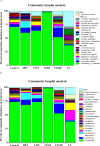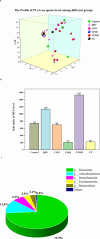Vaginal microbiome distinction in women with HPV+, cervical intraepithelial neoplasia, and cervical cancer, a retrospective study
- PMID: 39897478
- PMCID: PMC11782028
- DOI: 10.3389/fcimb.2024.1483544
Vaginal microbiome distinction in women with HPV+, cervical intraepithelial neoplasia, and cervical cancer, a retrospective study
Abstract
Introduction: The vaginal microbiota is a complex and dynamic micro-ecosystem that plays a pivotal role in protecting the host from various pathogens. Previous studies have investigated the diversity of the vaginal microbiome and its association with health outcomes, particularly the development of HPV-related disorders. This study aimed to investigate the correlation between the vaginal microbiota, HPV infection, cervical intraepithelial neoplasias (CINs), and cervical cancers in 69 women.
Methods: DNA was extracted from vaginal samples, followed by HPV genotyping through PCR and sequenced of the16S rRNA gene.
Results: Our results revealed that Lactobacillus was the predominant bacterium across all groups, with prevalence rates of 60.2% in women with HPV+, 63.9% in CINI, 97.7% in CINII, 52.0% in CINIII, 36.9% in cervical cancer, and 70.9% in NILM (normal cytology). Additionally, an elevated proportion of Gardnerella was identified as a high-risk bacterium associated with HPV infection, potentially contributing to the progression of cervical lesions. High-risk HPV genotypes, particularly HPV16, 52, and 33, were found to be more prevalent among women with HPV+, CIN, and cervical cancer. We also observed significantly higher alpha diversity in the vaginal microbiome of women with HPV+ and CIN, as indicated by increased Sobs, Shannon, Ace, and Chao indices, compared to the NILM group.
Conclusion: These findings suggest that HPV infection and its associated pathological conditions are closely linked to alterations in the vaginal microbiome. This underscores the need for further research to unravel the intricate relationship between HPV genotype infections and vaginal microbiota, which could pave the way for new diagnostic and therapeutic approaches.
Keywords: HPV genotypes; cervical cancer; cervical intraepithelial neoplasia; human papillomavirus; vaginal microbiome.
Copyright © 2025 Li and Wu.
Conflict of interest statement
The authors declare that the research was conducted in the absence of any commercial or financial relationships that could be construed as a potential conflict of interest.
Figures



References
-
- Aldunate M., Srbinovski D., Hearps A. C., Latham C. F., Ramsland P. A., Gugasyan R., et al. . (2015). Antimicrobial and immune modulatory effects of lactic acid and short chain fatty acids produced by vaginal microbiota associated with eubiosis and bacterial vaginosis. Front. Physiol. 6, 164. doi: 10.3389/fphys.2015.00164 - DOI - PMC - PubMed
MeSH terms
Substances
LinkOut - more resources
Full Text Sources
Medical
Miscellaneous

